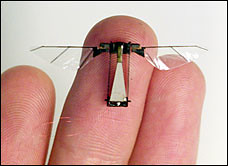It's 1 2 3, what are we payin' for?
One of the most amazing aspects of the United States Department of Defense has been its ability to innovate what eventually becomes broadly accessible civilian applications. The Internet is one, thanks to DARPA, and remote sensing is another, thanks to the needs of the Union Army. While taking a class whose purpose is to analyze remote sensing in all its detail, I've come to feel that the technology should have stayed within the confines of the Pentagon, I am tortured so).
The question becomes: What will the next generation of DoD innovations evolve to become? With this query I mind I searched the Department's archives to locate all the gizmos I had remembered seeing in magazines and Berkeley coffee houses that traffic in paranoia. There were the microwave rays, or Active Denial System; the robotic wasps that
explode C4 cartridges in the craws of unsuspecting enemies; even the gun that shoots out balls of an adhesive material reminiscent of the glue-like thread material Spider-Man stored in his spinnerets.

But I can't imagine that these would have widespread utility, at least not in the constructive way imagined by the teams that put the foundations for remote sensing and the Internet into place (once they had gotten past the hot air balloon stage.) Doubtless there are apparatuses being envisaged at the moment that no one outside the deepest chambers of Arlington can speak of, but my guess would be not. Why? There are any number of explanations. It's inarguable that the military-industrial complex has shifted to a self-serving enterprise, where military technology is now more expensive than at any time before, where the budget for the Defense Department rewards investments in junk projects like the Osprey, which seemingly crashes or blows up every few years, or Predator drones, which to date have managed to blow up an Afghan wedding, mortally wound a US service member, and kill an innocent civilian on the basis that he looked like Ayman al-Zawarhiri. Sure the DoD's budget as a percentage of GDP is less now than it was even during the Vietnam War, but such a statistic does not take into account the supplementary budgets use to fund Iraq and Afghanistan, or the secret budget outlays for, among other things, defense intelligence.
The gluttony of the Pentagon will no longer allow it to innovate outwardly. Technological tautology is now supreme, and old technologies will persist as long as they serve the central aim of taking out a target with as little collateral damage as possible. But then MRE's may show some promise for long distance runners...
No comments:
Post a Comment